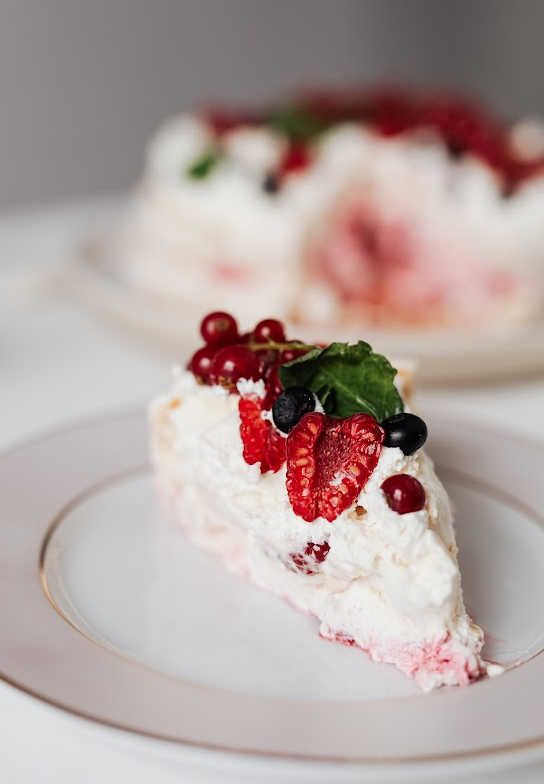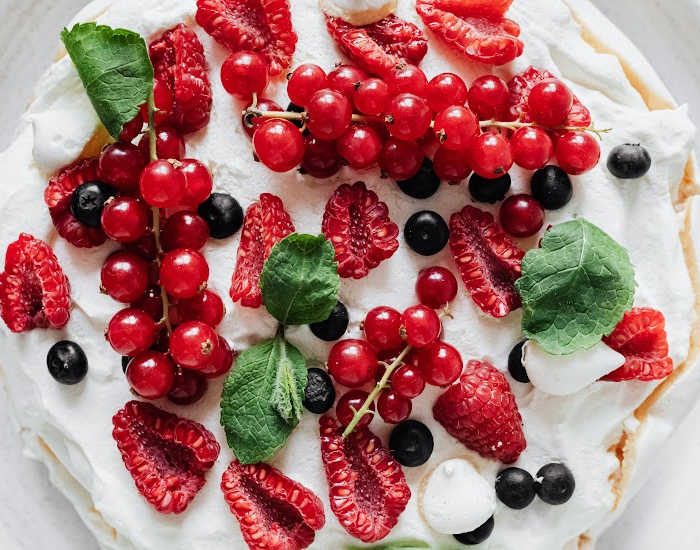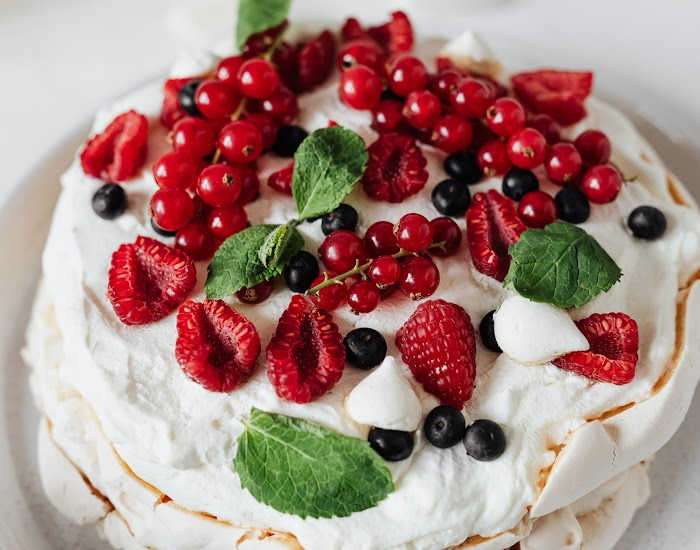Content Summary
Pavlova cake recipe - a delicious and beautiful dessert that is sure to have your guests coming back for more. This classic Pavlova cake recipe has all of the components you need to create a memorable pavlova experience.
From crunchy meringue bases to soft, fluffy cream fillings and juicy fruit toppings, pavlova cakes are the perfect way to whip up your holiday's dessert. So let's get baking!
What Is A Pavlova Cake?
Pavlova is a type of meringue-based cake named after the Russian ballerina Anna Pavlova. It's a very popular dessert in Australia and New Zealand, but gaining popularity in the United States too!
It's not like the meringue rolls. It usually consists of a large meringue that is crunchy on the outside and marshmallow-like on the inside, surrounded by whipped cream and topped with fresh fruit.



How To Make A Pavlova Cake
Ingredients:
- 4 egg whites, at room temperature
- 1 cup (or 8oz/225g) of superfine caster sugar (granulated white sugar)
- 2 teaspoons of cornstarch
- 1 teaspoon of white vinegar
- 1 teaspoon of vanilla extract
- 1/2 orange or yellow lemon fruit, for the juice
- 1 1/2 cups (350ml) of heavy whipping cream, whipped to stiff peaks
- Your favorite fruit for topping (strawberries, red berries, raspberries, blueberries, kiwis, etc.)
Instructions:
- Before you begin, set the oven to 300°F (150°C). Next, line a cookie sheet with parchment paper.
- Using an electric stand mixer or hand mixer on low speed, whip the egg whites in a clean bowl for 2 minutes or until bubbles start to form.
- Keep the machine on medium-high and keep whipping the egg whites until they start to form soft peaks. This process should take approximately 2-3 minutes.
- In a small bowl, add sugar, then cornflour, vanilla extract, and vinegar (or lemon juice).
- Add the sugar one tablespoon at a time, stirring until mixed in between each addition. The egg whites will double in volume and become glossy. Mix for two additional minutes then turn off the mixer.
- Shape the Pavlova into a 10-inch round on the cookie sheet, and create a small ditch in its center to hold cream later.
- Reduce your oven's temperature to 250°F (125°C). Bake your Pavlova for 1 hr 30 minutes. Once the timer goes off, turn off the oven but leave it in there for 3 hours or overnight, so it can dry out.
- For a delicious and beautiful dessert, top your Pavlova with whipped cream and fruit. Sliced strawberries, blueberries, raspberries, red berries, and wild berries are all excellent choices. Keep refrigerated until you're ready to serve for the best results!



What Is The Secret To A Good Pavlova?
The key to making a perfect Pavlova is all in the technique. You need to make sure your meringue has enough egg whites and sugar, and that the sugar is added gradually so it's well-incorporated.
You also need to make sure your Pavlova is baked at the correct temperature for the right amount of time, and given enough time to cool down before serving. Last but not least, Pavlova is best served with fresh cream and fruit and should be eaten within the first 30 hours.
How Do You Eat & Serve The Cake?
It's recommended to make Pavlova cake the day before because it is better when it has had a chance to dry out and cool. The Pavlova should be stored in the refrigerator until you're ready to serve.
Pavlova can be served in a variety of ways. You can make mini Pavlova cakes, and serve them as individuals, or make a large cake and cut into slices to share.
You can also serve Pavlova in a dessert bowl or dish, topped with fresh cream and fruit. If you're feeling adventurous, you can even top Pavlova with different types of fruit jams or coulis.





Tips & Tricks
1) Using Eggs:
- Start with room-temperature, fresh egg whites. Room-temperature eggs whip up better than those straight from the fridge.
- Freshness: Furthermore, the eggs must be fresh, because they'll whip up better and hold their shape better.
2) Using The Following Ingredients:
- Fine sugar is also known as castor sugar or regular sugar in the United States. This type of sugar is ideal for coffee because it dissolves better into the pavlova.
- Cornflour, or cornstarch, is key in keeping egg whites from weeping while baking. Although less cornflour is better, too much of it gives the meringue an unpleasant chalkiness – like in plenty of store-bought meringues. A good rule of thumb is to add one teaspoon per egg white.
- Adding an acidic ingredient, such as white vinegar, will stabilize the egg white foam and help to prevent a mixture that splits.
3) How To Whip Egg Whites:
- Begin mixing the egg whites on low for two minutes until they start to foam and develop bubbles.
- You'll know they're ready when you see soft peaks (check out the video below). Doing this simply allows the egg whites more time to stabilize.
4) Adding The Sugar:
- Take your time with this one: Add the sugar to the egg-white mixture bit by bit, only once it's whipped into soft peaks.
- Be patient when slowly incorporating the sugar - each tablespoon should be fully dissolved before adding more. The final product will be thick, glossy, and smooth.
5) The Perfect Timing & Temperature:
- Preheat oven to 250°F (125°C). Bake for 1hr 30min.
- Then, dry out in the oven on low heat for up to 3 hours.
- The combination of time & temperature will give you a crisp meringue shell with a soft center.
6) Topping Your Pavlova:
Top with fresh whipped cream and fruit. Garnish with any type of fresh fruits. Strawberries, raspberries, blueberries, forest berries, cherries and kiwis are all excellent Pavlova toppings!
Not sure which electric mixer is right for your baking needs? Check out the blog post below. We have selected 5 best affordable stand mixers, all in one place. Check them out!

Follow these pavlova tips to ensure the perfect pavlova every time! Happy Baking!
Catchy Finds
















